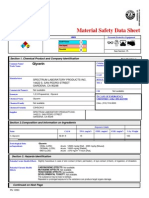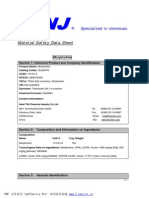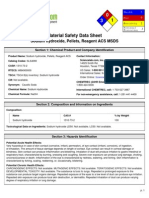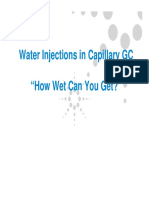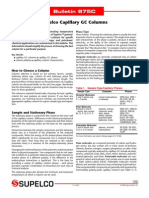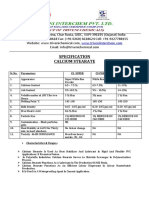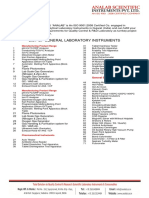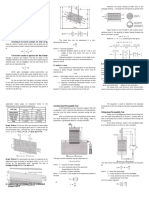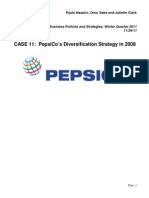Material Safety Data Sheet: Crotonaldehyde
Material Safety Data Sheet: Crotonaldehyde
Uploaded by
harsh421Copyright:
Available Formats
Material Safety Data Sheet: Crotonaldehyde
Material Safety Data Sheet: Crotonaldehyde
Uploaded by
harsh421Original Description:
Original Title
Copyright
Available Formats
Share this document
Did you find this document useful?
Is this content inappropriate?
Copyright:
Available Formats
Material Safety Data Sheet: Crotonaldehyde
Material Safety Data Sheet: Crotonaldehyde
Uploaded by
harsh421Copyright:
Available Formats
Material Safety Data Sheet
HMIS
NFPA
3
COR
Health Hazard
Fire Hazard
Reactivity
Personal Protective Equipment
4
3
0
See Section 15.
Section 1. Chemical Product and Company Identification
Common Name/
Trade Name
Manufacturer
Page Number: 1
Crotonaldehyde
Catalog
Number(s).
C2412, CR130, YY081
CAS#
4170-30-3
SPECTRUM CHEMICAL MFG. CORP.
14422 S. SAN PEDRO STREET
GARDENA, CA 90248
RTECS
GP9499000
TSCA
TSCA 8(b) inventory:
Crotonaldehyde
Commercial Name(s)
Not available.
CI#
Not available.
Synonym
2-Butanal
IN CASE OF EMERGENCY
CHEMTREC (24hr) 800-424-9300
Chemical Name
Chemical Family
Not available.
Chemical Formula
C4H6O
Supplier
SPECTRUM CHEMICAL MFG. CORP.
14422 S. SAN PEDRO STREET
GARDENA, CA 90248
CALL (310) 516-8000
Section 2.Composition and Information on Ingredients
Exposure Limits
Name
CAS #
1) Crotonaldehyde
Toxicological Data
on Ingredients
4170-30-3
Crotonaldehyde:
ORAL (LD50):
VAPOR (LC50):
TWA (mg/m )
6
STEL (mg/m3)
CEIL (mg/m3)
6
% by Weight
100
Acute: 206 mg/kg [Rat]. 104 mg/kg [Mouse].
Acute: 100 ppm 4 hour(s) [Rat]. 290 ppm 4 hour(s) [Mouse].
Section 3. Hazards Identification
Potential Acute Health Effects Extremely hazardous in case of skin contact (corrosive, irritant, permeator), of eye contact (irritant), of ingestion,
of inhalation. Liquid or spray mist may produce tissue damage particularly on mucous membranes of eyes, mouth
and respiratory tract. Skin contact may produce burns. Inhalation of the spray mist may produce severe irritation
of respiratory tract, characterized by coughing, choking, or shortness of breath. Severe over-exposure can result
in death. Inflammation of the eye is characterized by redness, watering, and itching. Skin inflammation is
characterized by itching, scaling, reddening, or, occasionally, blistering.
Continued on Next Page
Page Number: 2
Crotonaldehyde
Potential Chronic Health
Effects
Extremely hazardous in case of skin contact (corrosive, irritant, permeator), of eye contact (irritant), of ingestion,
of inhalation.
CARCINOGENIC EFFECTS: Not available.
MUTAGENIC EFFECTS: Not available.
TERATOGENIC EFFECTS: Not available.
DEVELOPMENTAL TOXICITY: Not available.
The substance is toxic to lungs, mucous membranes.
Repeated or prolonged exposure to the substance can produce target organs damage. Repeated or prolonged
contact with spray mist may produce chronic eye irritation and severe skin irritation. Repeated or prolonged
exposure to spray mist may produce respiratory tract irritation leading to frequent attacks of bronchial infection.
Repeated exposure to an highly toxic material may produce general deterioration of health by an accumulation in
one or many human organs. Repeated or prolonged inhalation of vapors may lead to chronic respiratory irritation.
Section 4. First Aid Measures
Eye Contact
Check for and remove any contact lenses. Immediately flush eyes with running water for at least 15 minutes,
keeping eyelids open. Cold water may be used. Do not use an eye ointment. Seek medical attention.
Skin Contact
If the chemical got onto the clothed portion of the body, remove the contaminated clothes as quickly as possible,
protecting your own hands and body. Place the victim under a deluge shower. If the chemical got on the victim's
exposed skin, such as the hands : Gently and thoroughly wash the contaminated skin with running water and
non-abrasive soap. Be particularly careful to clean folds, crevices, creases and groin. Cold water may be used.
If irritation persists, seek medical attention. Wash contaminated clothing before reusing.
Serious Skin Contact
Wash with a disinfectant soap and cover the contaminated skin with an anti-bacterial cream. Seek immediate
medical attention.
Inhalation
Allow the victim to rest in a well ventilated area. Seek immediate medical attention.
Serious Inhalation
Not available.
Ingestion
Do not induce vomiting. Examine the lips and mouth to ascertain whether the tissues are damaged, a possible
indication that the toxic material was ingested; the absence of such signs, however, is not conclusive. Loosen
tight clothing such as a collar, tie, belt or waistband. If the victim is not breathing, perform mouth-to-mouth
resuscitation. Seek immediate medical attention.
Serious Ingestion
Not available.
Section 5. Fire and Explosion Data
Flammability of the Product
Flammable.
Auto-Ignition Temperature
232C (449.6F)
Flash Points
CLOSED CUP: 12.8C (55F).
Flammable Limits
LOWER: 2.1% UPPER: 15.5%
Products of Combustion
These products are carbon oxides (CO, CO2).
Fire Hazards in Presence of
Various Substances
Flammable in presence of open flames and sparks, of heat, of oxidizing materials.
Explosion Hazards in Presence Risks of explosion of the product in presence of mechanical impact: Not available.
Risks of explosion of the product in presence of static discharge: Not available.
of Various Substances
Fire Fighting Media
and Instructions
Flammable liquid, soluble or dispersed in water.
SMALL FIRE: Use DRY chemical powder.
LARGE FIRE: Use alcohol foam, water spray or fog.
Special Remarks on
Fire Hazards
Explosive in the form of vapor when exposed to heat or flame.
Special Remarks on Explosion Not available.
Hazards
Continued on Next Page
Page Number: 3
Crotonaldehyde
Section 6. Accidental Release Measures
Small Spill
Dilute with water and mop up, or absorb with an inert dry material and place in an appropriate waste disposal
container. Finish cleaning by spreading water on the contaminated surface and dispose of according to local and
regional authority requirements.
Large Spill
Flammable liquid. Corrosive liquid.
Keep away from heat. Keep away from sources of ignition. Stop leak if without risk. Absorb with DRY earth,
sand or other non-combustible material. Do not get water inside container. Do not touch spilled material. Use
water spray curtain to divert vapor drift. Prevent entry into sewers, basements or confined areas; dike if needed.
Eliminate all ignition sources. Call for assistance on disposal. Be careful that the product is not present at a
concentration level above TLV. Check TLV on the MSDS and with local authorities.
Section 7. Handling and Storage
Precautions
Keep locked up Keep container dry. Keep away from heat. Keep away from sources of ignition. Ground all
equipment containing material. Do not ingest. Do not breathe gas/fumes/ vapour/spray. Never add water to this
product In case of insufficient ventilation, wear suitable respiratory equipment If ingested, seek medical advice
immediately and show the container or the label. Avoid contact with skin and eyes
Storage
Flammable materials should be stored in a separate safety storage cabinet or room. Keep away from heat. Keep
away from sources of ignition. Keep container tightly closed. Keep in a cool, well-ventilated place. Ground all
equipment containing material. A refrigerated room would be preferable for materials with a flash point lower than
37.8C (100F).
Section 8. Exposure Controls/Personal Protection
Engineering Controls
Provide exhaust ventilation or other engineering controls to keep the airborne concentrations of vapors below their
respective threshold limit value. Ensure that eyewash stations and safety showers are proximal to the
work-station location.
Personal Protection
Face shield. Full suit. Vapor respirator. Be sure to use an approved/certified respirator or equivalent. Gloves.
Boots.
Personal Protection in Case of Splash goggles. Full suit. Vapor respirator. Boots. Gloves. A self contained breathing apparatus should be
a Large Spill
used to avoid inhalation of the product. Suggested protective clothing might not be sufficient; consult a specialist
BEFORE handling this product.
Exposure Limits
TWA: 2 CEIL: 6 (ppm)
TWA: 6 CEIL: 18 (mg/m3)
Consult local authorities for acceptable exposure limits.
Section 9. Physical and Chemical Properties
Physical state and appearance Liquid.
Molecular Weight
70.09 g/mole
pH (1% soln/water)
Not available.
Boiling Point
102C (215.6F)
Melting Point
-75C (-103F)
Critical Temperature
Not available.
Specific Gravity
0.8531 (Water = 1)
Vapor Pressure
30 mm of Hg (@ 20C)
Vapor Density
2.41 (Air = 1)
Volatility
Not available.
Odor Threshold
7 ppm
Water/Oil Dist. Coeff.
Not available.
Continued on Next Page
Odor
Pungent. Irritant.
Taste
Not available.
Color
Clear Colorless.
Page Number: 4
Crotonaldehyde
Ionicity (in Water)
Not available.
Dispersion Properties
See solubility in water.
Solubility
Soluble in cold water.
Section 10. Stability and Reactivity Data
Stability
The product is stable.
Instability Temperature
Not available.
Conditions of Instability
Not available.
Incompatibility with various
substances
Not available.
Corrosivity
Non-corrosive in presence of glass.
Special Remarks on
Reactivity
Not available.
Special Remarks on
Corrosivity
Not available.
Polymerization
No.
Section 11. Toxicological Information
Routes of Entry
Dermal contact. Eye contact. Inhalation. Ingestion.
Toxicity to Animals
WARNING: THE LC50 VALUES HEREUNDER ARE ESTIMATED ON THE BASIS OF A 4-HOUR EXPOSURE.
Acute oral toxicity (LD50): 104 mg/kg [Mouse].
Acute toxicity of the vapor (LC50): 100 ppm 4 hour(s) [Rat].
Chronic Effects on Humans
The substance is toxic to lungs, mucous membranes.
Other Toxic Effects on
Humans
Extremely hazardous in case of skin contact (corrosive, irritant, permeator), of ingestion, of inhalation.
Special Remarks on
Toxicity to Animals
Not available.
Special Remarks on
Chronic Effects on Humans
Not available.
Special Remarks on other
Toxic Effects on Humans
Not available.
Section 12. Ecological Information
Ecotoxicity
Not available.
BOD5 and COD
Not available.
Products of Biodegradation
Possibly hazardous short term degradation products are not likely. However, long term degradation products may
arise.
Toxicity of the Products
of Biodegradation
The products of degradation are more toxic.
Special Remarks on the
Products of Biodegradation
Not available.
Continued on Next Page
Page Number: 5
Crotonaldehyde
Section 13. Disposal Considerations
Waste Disposal
Section 14. Transport Information
DOT Classification
CLASS 6.1: Poisonous material.
Identification
: Crotonaldehyde, stabilized : UN1143 PG: I
Special Provisions for
Transport
Hazard Zone B Marine Pollutant
DOT (Pictograms)
Section 15. Other Regulatory Information and Pictograms
Federal and State
Regulations
Pennsylvania RTK: Crotonaldehyde
Massachusetts RTK: Crotonaldehyde
TSCA 8(b) inventory: Crotonaldehyde
SARA 302/304/311/312 extremely hazardous substances: Crotonaldehyde
SARA 313 toxic chemical notification and release reporting: Crotonaldehyde
CERCLA: Hazardous substances.: Crotonaldehyde
California
Proposition 65
Warnings
Other Regulations
OSHA: Hazardous by definition of Hazard Communication Standard (29 CFR 1910.1200).
Other Classifications
WHMIS (Canada)
DSCL (EEC)
HMIS (U.S.A.)
Health Hazard
Fire Hazard
Reactivity
Personal Protection
WHMIS (Canada)
(Pictograms)
DSCL (Europe)
(Pictograms)
Continued on Next Page
CLASS B-2: Flammable liquid with a flash point lower than 37.8C (100F).
CLASS D-1A: Material causing immediate and serious toxic effects (VERY TOXIC).
CLASS D-2B: Material causing other toxic effects (TOXIC).
R11- Highly flammable.
R22- Harmful if swallowed.
R26- Very toxic by inhalation.
R35- Causes severe burns.
4
3
0
National Fire Protection
Association (U.S.A.)
Flammability
3
Health
COR
Reactivity
Specific hazard
Page Number: 6
Crotonaldehyde
TDG (Canada)
(Pictograms)
ADR (Europe)
(Pictograms)
Protective Equipment
Gloves.
Full suit.
Vapor respirator. Be sure to use an
approved/certified respirator or
equivalent. Wear appropriate respirator
when ventilation is inadequate.
Face shield.
Section 16. Other Information
MSDS Code
C4840
References
Not available.
Other Special
Considerations
Not available.
Validated by Sonia Owen on 8/11/2006.
Verified by Sonia Owen.
Printed 9/11/2006.
CALL (310) 516-8000
Notice to Reader
All chemicals may pose unknown hazards and should be used with caution. This Material Safety Data Sheet (MSDS) applies only to the material as packaged. If this product is
combined with other materials, deteriorates, or becomes contaminated, it may pose hazards not mentioned in this MSDS. It shall be the user's responsibility to develop proper
methods of handling and personal protection based on the actual conditions of use. While this MSDS is based on technical data judged to be reliable, Spectrum Quality Products,
Inc. assumes no responsibility for the completeness or accuracy of the information contained herein.
You might also like
- Cumene MSDS: Section 1: Chemical Product and Company IdentificationDocument5 pagesCumene MSDS: Section 1: Chemical Product and Company Identificationburhanettin_erdemNo ratings yet
- Msds - ChlorobenzeneDocument5 pagesMsds - ChlorobenzenekffabellonNo ratings yet
- Msds Acetyl ChlorideDocument6 pagesMsds Acetyl ChlorideghungrudswapnilNo ratings yet
- ChlorobutanolDocument6 pagesChlorobutanolSoni Setia BudiawanNo ratings yet
- Msds of GlycidolDocument6 pagesMsds of GlycidolDinesh TanwarNo ratings yet
- Msds GlycerinDocument6 pagesMsds Glycerinapi-263411629No ratings yet
- Ethyl ChlorideDocument5 pagesEthyl ChlorideAprilia SusantiNo ratings yet
- SDS e Glycerine PDFDocument9 pagesSDS e Glycerine PDFEdy WijayaNo ratings yet
- Tri Ethyl A MineDocument6 pagesTri Ethyl A MineJwalant NaikNo ratings yet
- Potassium Hydroxide Solution, 20% MSDS: Section 1: Chemical Product and Company IdentificationDocument6 pagesPotassium Hydroxide Solution, 20% MSDS: Section 1: Chemical Product and Company IdentificationibessemalinaNo ratings yet
- MEADocument6 pagesMEAGhifaris VashaNo ratings yet
- GlycerinDocument6 pagesGlycerinSusan Carolina Lozano VergaraNo ratings yet
- Msds Titipan1Document5 pagesMsds Titipan1anitacahyaNo ratings yet
- Potassium Hydroxide MSDS: Section 1: Chemical Product and Company IdentificationDocument6 pagesPotassium Hydroxide MSDS: Section 1: Chemical Product and Company IdentificationMaulidaKhusnulNo ratings yet
- MsdsDocument6 pagesMsdsRoby SuheriNo ratings yet
- MsdsDocument5 pagesMsdsNoe Noe TarsonoNo ratings yet
- Msds NitobenzeneDocument5 pagesMsds NitobenzeneAnngie Nove SimbolonNo ratings yet
- Metil AcrilatoDocument6 pagesMetil Acrilatosoulwizard00No ratings yet
- Butil AlkoholDocument6 pagesButil Alkoholmicaziv4786No ratings yet
- MSDS 2,3,5 CollidineDocument5 pagesMSDS 2,3,5 CollidineSiddhant ChhabraNo ratings yet
- Acetic Anhydride MSDS: Section 1: Chemical Product and Company IdentificationDocument6 pagesAcetic Anhydride MSDS: Section 1: Chemical Product and Company IdentificationAdri MuntahaNo ratings yet
- Msds Ac2oDocument6 pagesMsds Ac2oArfin FardiansyahNo ratings yet
- Methyl Methacrylate MSDS: Section 1: Chemical Product and Company IdentificationDocument5 pagesMethyl Methacrylate MSDS: Section 1: Chemical Product and Company IdentificationDriya HersetaNo ratings yet
- MSDS Etilen DiaminDocument6 pagesMSDS Etilen DiamindoubleyujeiNo ratings yet
- MSDS MorpholineDocument8 pagesMSDS MorpholineRoDo AlfaroNo ratings yet
- Msds Butyl AcetateDocument6 pagesMsds Butyl AcetateArsalan Ahmad KhanNo ratings yet
- Sodium Hypochlorite, 12% MSDS: Section 1: Chemical Product and Company IdentificationDocument6 pagesSodium Hypochlorite, 12% MSDS: Section 1: Chemical Product and Company IdentificationMohamed MaghawryNo ratings yet
- 1,2 DichloroethaneDocument6 pages1,2 DichloroethanePara Redha Prima BahriNo ratings yet
- Msds Methylene ChlorideDocument3 pagesMsds Methylene ChlorideCharles FuNo ratings yet
- Sodium Hydroxide, Pellets, Reagent ACS MSDS: Section 1: Chemical Product and Company IdentificationDocument6 pagesSodium Hydroxide, Pellets, Reagent ACS MSDS: Section 1: Chemical Product and Company IdentificationMohamed MaghawryNo ratings yet
- Msds 1Document5 pagesMsds 1Dick Ferieno FirdausNo ratings yet
- Acetophenon PDFDocument6 pagesAcetophenon PDFYuris Yurdiansah Munandar0% (1)
- Acetophenone PDFDocument6 pagesAcetophenone PDFYuliana Ja'farNo ratings yet
- CikloheksilaminDocument6 pagesCikloheksilaminmicaziv4786No ratings yet
- Sodium Hypochlorite 12% PDFDocument6 pagesSodium Hypochlorite 12% PDFTaufiq Nur RachmanNo ratings yet
- Alil AlkoholDocument5 pagesAlil AlkoholDewi TitaNo ratings yet
- (ch3) 2so4Document6 pages(ch3) 2so4arbol100No ratings yet
- Msds NonaneDocument5 pagesMsds Nonanenirmal_subudhiNo ratings yet
- Mono Ethanol A MineDocument8 pagesMono Ethanol A MinednglemariamenateNo ratings yet
- Msds PentaneDocument6 pagesMsds PentaneMuhammad FikriansyahNo ratings yet
- Material Safety Data Sheet Nitric AcidDocument7 pagesMaterial Safety Data Sheet Nitric AcidtradeasiagroupNo ratings yet
- Potassium Hydroxide. 0.5N (Alcoholic) MSDS: Section 1: Chemical Product and Company IdentificationDocument6 pagesPotassium Hydroxide. 0.5N (Alcoholic) MSDS: Section 1: Chemical Product and Company IdentificationibessemalinaNo ratings yet
- Print PDFDocument6 pagesPrint PDFseptika5426No ratings yet
- Asam KloridaDocument6 pagesAsam KloridaMutia Nurul OctaviaNo ratings yet
- Mercuric Chloride MSDS: Section 1: Chemical Product and Company IdentificationDocument6 pagesMercuric Chloride MSDS: Section 1: Chemical Product and Company IdentificationFitria Wahyu KurniawatiNo ratings yet
- Msds Diaseton AlkoholDocument5 pagesMsds Diaseton AlkoholtakenoveraccountNo ratings yet
- Amil AlkoholDocument6 pagesAmil AlkoholJ FadliNo ratings yet
- Sodium Hydroxide MSDS: Section 1: Chemical Product and Company IdentificationDocument6 pagesSodium Hydroxide MSDS: Section 1: Chemical Product and Company IdentificationRahmadPRtgNo ratings yet
- Msds ButanolDocument6 pagesMsds ButanolMaria Regina SudiartaNo ratings yet
- DMSO MsdsDocument6 pagesDMSO MsdsDavid FooNo ratings yet
- Cinna Mal de HideDocument5 pagesCinna Mal de Hiderully1234No ratings yet
- After a Disaster - Information to Help You and Your Family RecoverFrom EverandAfter a Disaster - Information to Help You and Your Family RecoverNo ratings yet
- Georgia Pest Management Handbook: 2021 Home and Garden EditionFrom EverandGeorgia Pest Management Handbook: 2021 Home and Garden EditionEmily CabreraNo ratings yet
- Improvised Munitions Handbook – Learn How to Make Explosive Devices & Weapons from Scratch (Warfare Skills Series): Illustrated & With Clear InstructionsFrom EverandImprovised Munitions Handbook – Learn How to Make Explosive Devices & Weapons from Scratch (Warfare Skills Series): Illustrated & With Clear InstructionsRating: 3.5 out of 5 stars3.5/5 (7)
- Practical Patch Testing and Chemical Allergens in Contact DermatitisFrom EverandPractical Patch Testing and Chemical Allergens in Contact DermatitisNo ratings yet
- Water InjectionsDocument52 pagesWater Injectionsharsh421No ratings yet
- Supelco Capillary GC ColumnsDocument36 pagesSupelco Capillary GC ColumnsluquisboNo ratings yet
- 6724 ColumnDocument1 page6724 Columnharsh421No ratings yet
- 2 Disbursement Request FormDocument1 page2 Disbursement Request Formharsh421No ratings yet
- Calcium Stearate Coa Spec TiplDocument2 pagesCalcium Stearate Coa Spec Tiplharsh421No ratings yet
- (Chiron) CM151979 - Kanoria Chemicals - V1.0Document2 pages(Chiron) CM151979 - Kanoria Chemicals - V1.0harsh421No ratings yet
- Premium Paid AcknowledgementDocument1 pagePremium Paid Acknowledgementharsh421No ratings yet
- Free Flow Granular Modified PTFEDocument8 pagesFree Flow Granular Modified PTFEharsh421No ratings yet
- Invite Vadodra 3rd AugDocument2 pagesInvite Vadodra 3rd Augharsh421No ratings yet
- Contech CatalogueDocument24 pagesContech Catalogueharsh421No ratings yet
- Catalog-2015 - 17Document164 pagesCatalog-2015 - 17harsh421No ratings yet
- 1daily Re Dec. - 15Document12 pages1daily Re Dec. - 15harsh421No ratings yet
- Analab Product ListDocument1 pageAnalab Product Listharsh421No ratings yet
- Chemical Spills and Leaks: Do KnowDocument1 pageChemical Spills and Leaks: Do Knowharsh421No ratings yet
- FHKSBTK Y.400 JR Yt"Thftzo Ftze Ytv T Cu Nïm VFZTGT: Cejebtuhtbtk Btajelt Y:Tktk Cltjjt:E Vujt E Cthu 'Wdo"Document1 pageFHKSBTK Y.400 JR Yt"Thftzo Ftze Ytv T Cu Nïm VFZTGT: Cejebtuhtbtk Btajelt Y:Tktk Cltjjt:E Vujt E Cthu 'Wdo"harsh421No ratings yet
- GujaratiDocument1 pageGujaratiharsh421No ratings yet
- ANNUAL-LEAVE-BENEFITS ResolutionDocument2 pagesANNUAL-LEAVE-BENEFITS ResolutionBARANGAY ONE POBLACIONNo ratings yet
- MCQ Nego 3 QuizDocument8 pagesMCQ Nego 3 QuizRhonel John Villarubin Reyes75% (4)
- Devoir de Contrôle N°3 - Anglais - 2ème Economie & Gestion (2023-2024) Mlle - NSIRI - SiwarDocument3 pagesDevoir de Contrôle N°3 - Anglais - 2ème Economie & Gestion (2023-2024) Mlle - NSIRI - Siwarriadh95200No ratings yet
- Bhanu Prakash S.G: Professional SummaryDocument3 pagesBhanu Prakash S.G: Professional SummarySunkadahalli Govindaiah Bhanu PrakashNo ratings yet
- 10 - Lesson Sheet - Sine and Cosine FunctionsDocument15 pages10 - Lesson Sheet - Sine and Cosine FunctionsIgnacio TOLMOS DUEÑASNo ratings yet
- Niche 1Document87 pagesNiche 1swordprakashNo ratings yet
- KPI and Supplier Performance Scorecard ToolDocument7 pagesKPI and Supplier Performance Scorecard ToolJayant Kumar JhaNo ratings yet
- Spare Parts List For Machine No. 208039 ARBURG Plastik Enjeksiyon Makinalari San - Ve Tic. LTD - StiDocument366 pagesSpare Parts List For Machine No. 208039 ARBURG Plastik Enjeksiyon Makinalari San - Ve Tic. LTD - StiMustafa GunduzNo ratings yet
- 06 Social Science Civics Key Notes Ch08 Rural LivelihoodsDocument3 pages06 Social Science Civics Key Notes Ch08 Rural LivelihoodsNitin PatsariyaNo ratings yet
- NO Recipes McKenzie BakeryDocument3 pagesNO Recipes McKenzie BakerynicoleNo ratings yet
- Harley DavidsonDocument22 pagesHarley DavidsonSandeep Yadav33% (3)
- Barometer and Atmospheric PressureDocument2 pagesBarometer and Atmospheric PressureEhtisham RiazNo ratings yet
- Teaching Grammar Goals and Techniques For Teaching GrammarDocument6 pagesTeaching Grammar Goals and Techniques For Teaching Grammarмирослава Турук100% (1)
- BG 80 Ultrasonic Bolt GaugeDocument46 pagesBG 80 Ultrasonic Bolt GaugetylerdurdaneNo ratings yet
- Nanoworld: NanotechnologyDocument17 pagesNanoworld: NanotechnologyAizel AlmonteNo ratings yet
- The Philisophical Works of David Hume Vol I PDFDocument484 pagesThe Philisophical Works of David Hume Vol I PDFRaul MercauNo ratings yet
- Dead RisingDocument11 pagesDead RisingJuan Emmanuel Ponce de LeónNo ratings yet
- Permeability of SoilsDocument6 pagesPermeability of SoilsJoanna GuidoNo ratings yet
- Crustal Magmatic Controls On The Formation of Porphyry Copper Deposits - Nature Reviews Earth & EnvironmentDocument34 pagesCrustal Magmatic Controls On The Formation of Porphyry Copper Deposits - Nature Reviews Earth & EnvironmentYANNo ratings yet
- Case Analysis PepsiCoDocument15 pagesCase Analysis PepsiCoMohammad KhaledNo ratings yet
- Impact of Brand Personality On Consumers - Emotional Brand Attachment To Skincare ProductsDocument19 pagesImpact of Brand Personality On Consumers - Emotional Brand Attachment To Skincare Productscontacto.camilalayNo ratings yet
- Logistics and Supply Chain OperationsDocument13 pagesLogistics and Supply Chain OperationsaleenawaltersNo ratings yet
- Draft Newsletter April 2024Document27 pagesDraft Newsletter April 2024Kumara Tungga DewaNo ratings yet
- Erlang OTP System Documentation 10.7Document378 pagesErlang OTP System Documentation 10.7Anonymous 3NmUUDtNo ratings yet
- Beyond SufferingDocument344 pagesBeyond SufferingDragoș RusuNo ratings yet
- Horizontal and Vertical PlaneDocument13 pagesHorizontal and Vertical PlaneUlanNo ratings yet
- Examining The Impact of Street Vending oDocument17 pagesExamining The Impact of Street Vending otafadzwa nyabezeNo ratings yet
- CPM and PertDocument49 pagesCPM and PertMeeraNo ratings yet
- Edp Unit 1 Bba Sem 5Document21 pagesEdp Unit 1 Bba Sem 5NISHANo ratings yet
- Signals and SystemsDocument1 pageSignals and Systemsडाँ सूर्यदेव चौधरीNo ratings yet











